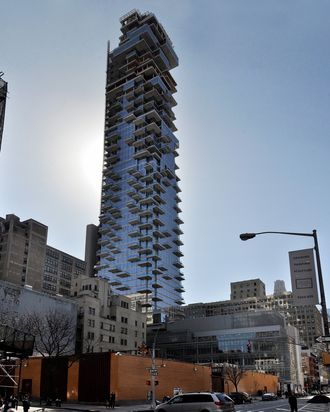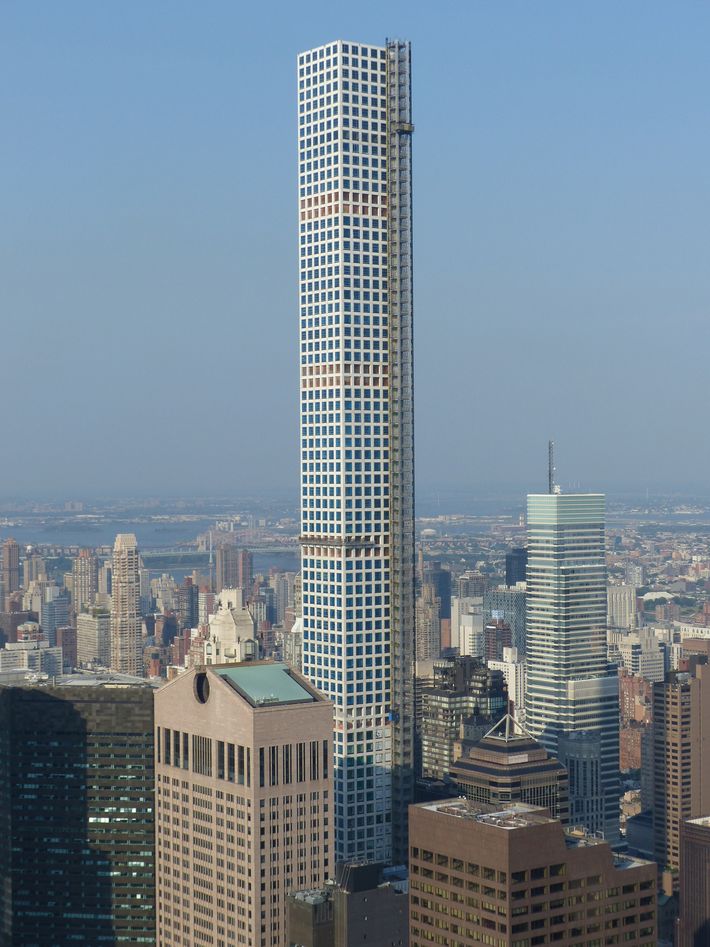
Spare a thought for the burdens of extreme wealth. Ordinary travelers might enjoy spending the occasional night in a preexisting hotel, walking on unfamiliar streets, even braving a foreign menu. But the ultrarich are different from you and me. When they visit New York, they inhabit specially constructed towers high enough to limit their contact with the earth. Each is a vertical Alcatraz, linked to the mainland by high-speed elevator but still unimaginably distant from the city’s life.
In the spirit of Jacob Riis, the crusading reporter and photographer who toured New York’s most abject slums in the late 19th century and reported back in How the Other Half Lives, I have regularly ventured into the regions where billionaires crouch in decorative isolation. Most recently, I toured two high-security facilities: 56 Leonard Street, a stack of gray glass cages that looms darkly over Tribeca; and 432 Park Avenue, a Sauron-like tower that heaves 1,400 feet up above midtown, making even the Empire State Building look stumpy.

From a distance, the buildings appear elegant, even noble, and apparently useful. Herzog & de Meuron’s 56 Leonard Street has a moody glamour, climbing into the sky on staggered cantilevers, as if the solid shaft were scattering into pixels on its way up. Rafael Viñoly’s 432 Park Avenue looks like Cartesian logic embodied in concrete, its stacked grids of ten-by-ten-foot windows punctuated at regular intervals by two-story bands of light. It masquerades as a natural outgrowth of Manhattan’s demand for density. In fact, though, the living quarters don’t even begin until a third of the way up: below are offices, staff quarters, and mechanical rooms. Those rhythmic, windowless interruptions are actually inaccessible terraces that serve mostly to boost the upper floors farther into the clouds, since they don’t count toward the building’s allowable square footage.
It is rare to spot the denizens of these habitats, and aside from the staff, a clutch of busy decorators, and a lone highly polished female striding through an echoing lobby, I encountered nobody. Still, even the empty dwellings speak eloquently of living conditions up there. The ultrawealthy have their noses pressed to the glass like airline passengers with a window seat, gazing out at the world that teems invitingly below. At 56 Leonard, some of the units have their own elevated exercise yards, circled by glass railings to create the illusion of freedom. There are handles on the windows, which the inmates can crack them open, but that is mostly a taunt: building employees can unseal the glass walls to provide access to window cleaners. “Residents” of 432 Park do have access to fresh air — all they have to do to get it is get down on their knees, lift a wooden flap on a window bench, reach in and unlatch another panel to let a draft of whistling wind and street noise sneak through the exterior mesh and internal metal grille. Hardly anyone bothers, and so most of the time all is inhumanly quiet.
To be sure, the inmates of these levitating dungeons believe they are being pampered. They have room to stretch, plenty to eat, and access to round-the-clock cable TV. But the psychological impact of life in such extreme conditions is hard to fathom. On sunny days, sunlight pounds blindingly through glass walls, ricocheting off white-oak floors and glossy white surfaces, and making the closets seem invitingly shaded. In gray weather, fog shrouds the living quarters, confronting residents with the blankness of a near-death experience. The uppermost penthouse at 56 Leonard Street has 19-foot ceilings, high enough to make you feel like you’re at the bottom of a well rather than on top of the world.
One oppressive peculiarity of these penthouses is the lack of privacy when it comes to hygiene. This is a deluxe twist on 19th-century tenement living, when 12 families shared an outhouse and the sit-tub was in the kitchen. Here, those memories of squalor have been gilded into new forms of public ablutions. At 56 Leonard, the bathtub is placed at the edge of one cantilevered glass box, which affords the bather a view of the far-off metropolis they nominally inhabit, and also treats the upstairs neighbors to a view of the bather. In daytime, the reflective glass surface frustrates voyeurs, but in the evening, when the lights go on, all is revealed. At 432 Park, the locker-room-sized bathroom contains a glass-walled toilet stall, so that each penthouse’s cellmates need never lose sight of each other.
In theory, residents are free to leave the premises at any time, to wander the streets, even to buy a hot dog from a vendor. Over time, though, the architecture erodes their sense of independence. These Rapunzelian towers include intimidatingly large “kitchens” that could, in theory, function as areas in which to prepare and consume food. In practice, many subjects are so terrified of marring the sterile surfaces that they choose — if that word truly applies — to eat in communal dining rooms, within the building perimeter. At 432 Park Avenue, it is located on the 12th floor and, as at Rikers Island, is for residents only.
*This article originally stated that only building employee can open the windows at 56 Leonard. Residents can tilt open the windows. Additionally, this story said 432 Park housed a hotel on its lower floors. It does not. The post has been fixed and updated.






























